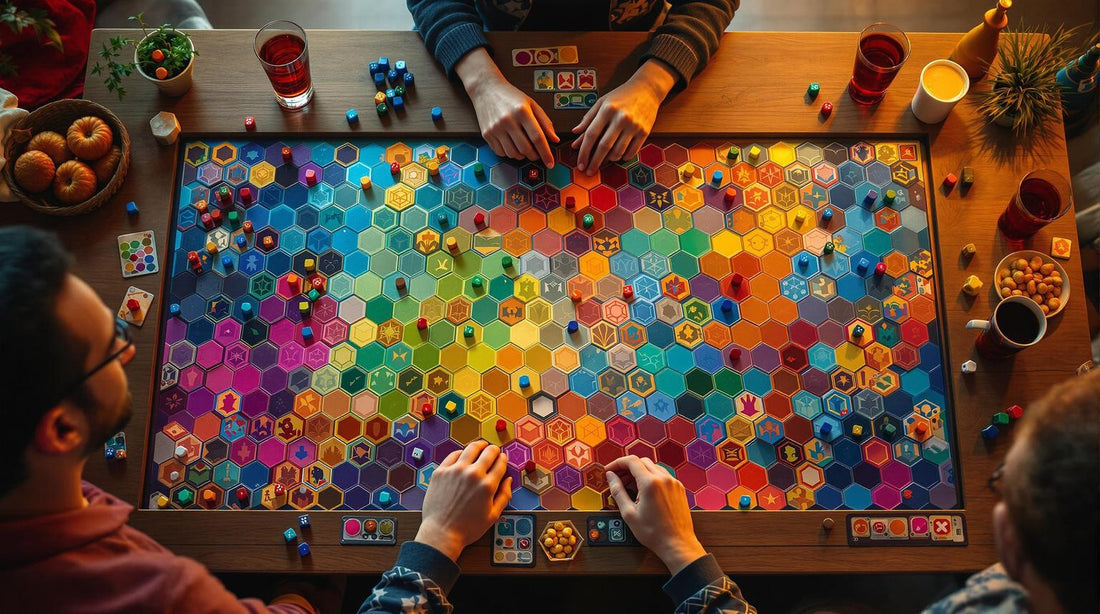Discover the Best Board Games for Every Player

Variable Turn Order Mechanics Explained
Variable Turn Order (VTO) adds unpredictability to games by changing the sequence of turns dynamically. Unlike fixed turn orders, VTO uses methods like shuffled decks, token draws, or player-controlled systems to determine who acts next. This mechanic keeps gameplay engaging, encourages flexible strategies, and balances player interactions.
Key Features of VTO:
- Random Turn Systems: Use shuffled decks or token draws (e.g., Aeon's End).
- Player Choice: Players influence turn order via decisions (e.g., For What Remains).
- Built-in Systems: Pre-defined mechanics like initiative tokens (Adventure Tactics).
- Mitigation Tools: Elements like "Fate Tokens" allow limited control over randomness.
Benefits of VTO:
- Increased Interaction: Players adapt to ever-changing sequences.
- Balanced Gameplay: Reduces first-mover advantage and ensures fairness.
- Strategic Depth: Encourages on-the-fly decision-making.
Quick Comparison:
| Turn System Type | Example Game | Mechanic | Player Control |
|---|---|---|---|
| Random | Aeon's End | Shuffled turn decks | Low |
| Player Choice | For What Remains | Activation token draws | High |
| Built-in | Adventure Tactics | Initiative token swapping | Medium |
| Token-based | The Plum Island Horror | Bag drawing | Low |
VTO mechanics challenge traditional turn orders by introducing variety and unpredictability, making games more dynamic and strategic. Keep reading to explore how these systems work and how they can enhance your gaming experience.
10+ Turn Order Systems in Tabletop Games
Common Turn Order Systems
Turn order systems in games can vary widely, each bringing its own flavor of strategy and unpredictability to the table. These methods add depth and offer players different ways to approach their decisions.
Player Choice Systems
In these systems, players have direct control over the turn order. For instance, in For What Remains, players secretly select activation tokens for their characters. These tokens are drawn one at a time, and once used, they remain unavailable until refreshed. This setup encourages thoughtful planning while minimizing the advantage of always going first.
Built-in Game Systems
Built-in systems are designed around pre-defined game mechanics. A great example is Adventure Tactics: Adventures in Alchemy, which uses a Fate Counter that allows players to trade tokens for a more favorable turn sequence. Other games include mechanisms to prevent consecutive turns by the same player, helping to maintain balance and fairness.
Random and Shared Turns
Random systems rely on chance to determine turn order. For example, Aeon's End uses a turn deck system with tools to reduce randomness, while The Plum Island Horror employs token draws from a bag. Some games, like Kinfire Chronicles, incorporate balancing mechanisms such as Fate Tokens, giving players some control over outcomes. This game even allows a switch to a fixed initiative system if needed.
| Turn System Type | Example Game | Key Mechanic | Player Control Level |
|---|---|---|---|
| Player Choice | For What Remains | Activation Token Selection | High |
| Built-in | Adventure Tactics | Initiative Token Swapping | Medium |
| Random | Aeon's End | Turn Order Deck | Low (with mitigation) |
| Token-based | The Plum Island Horror | Bag Drawing | Low |
sbb-itb-1ed942f
Effects on Game Experience
Variable turn orders shake up gameplay by introducing new challenges to traditional strategies and player interactions.
Decision Making
With variable turn orders, players face added complexity in planning. Since sequences are unpredictable, they must prepare for several possible outcomes. For instance, a player might unexpectedly get multiple turns in a row, requiring flexible strategies and backup plans.
Player Interaction
This unpredictability naturally enhances how players interact. Constantly shifting turn orders keep everyone on their toes, encouraging quick thinking and collaboration. This is especially engaging in cooperative games, where teamwork thrives on adapting to surprises.
Game Balance
To maintain fairness, variable turn orders often require specific balancing mechanisms. Here are a few examples:
| Balance Mechanism | Implementation | Impact on Gameplay |
|---|---|---|
| Fate Tokens | Limited resource for adjusting turn order | Adds strategic depth at key moments |
| Static Initiative | Optional fixed turn order | Offers stability when needed |
| Turn Limitations | Rules that prevent back-to-back turns | Keeps gameplay equitable |
The impact of these mechanisms can depend on the number of players. For example, in UnMatched Adventures, solo play revealed challenges with turn order due to a smaller initiative deck. Playtesting determined that using four Fate Tokens worked best to balance solo sessions.
Design Guidelines
Incorporate variable turn orders to add unpredictability, balance, and depth to your game mechanics.
Common Problems
Understanding the challenges of variable turn orders is key to improving their design. Poorly balanced turn sequences can disrupt gameplay and reduce player engagement.
| Problem | Impact | Mitigation Strategy |
|---|---|---|
| First-mover Advantage | White wins 55% of decisive chess games among non-elite players | Turn order compensation |
| Turn Order Imbalance | Creates a 64% win rate advantage in high-level play | Dynamic adjustments |
| Strategic Uncertainty | Makes long-term planning difficult for players | Fate Tokens |
Moving earlier gives a player a greater opportunity to "set the stage", whereas moving later enables a player to observe the move of its opponent and respond to it.
This insight from Steven J. Brams highlights the dual nature of turn timing.
Thorough playtesting is essential to refine these mechanics, ensuring gameplay remains engaging and fair.
Testing Requirements
Build your design process around playtesting. Everything else is theorycraft.
Eric Lang emphasizes the importance of iterative testing.
Key areas to focus on during testing include:
-
Systematic Data Collection
- Track game duration for different player counts.
- Analyze win rates based on turn position.
- Measure how often consecutive turns occur.
- Gather player satisfaction data.
-
Diverse Testing Groups
-
Test with a variety of players to ensure balance across skill levels. As John Brieger points out:
Your playtesters' minor irritants of today are your reviewers' slams of tomorrow.
-
Test with a variety of players to ensure balance across skill levels. As John Brieger points out:
-
Edge Case Analysis
- Evaluate maximum consecutive turns.
- Monitor intervals between turns.
- Test limits on turn manipulation.
- Assess how well mitigation systems work.
Steve Jackson offers a critical reminder:
If your testers say it takes too long, what they really mean is they're not having enough fun.
Final Thoughts
Main Points
Variable Turn Order (VTO) mechanics change the way games are played by adding an element of unpredictability. This creates opportunities for dynamic planning and more complex strategies.
| Aspect | Traditional Turn Order | Variable Turn Order |
|---|---|---|
| Player Agency | Fixed sequence | Dynamic choices |
| Strategic Depth | Predictable planning | Flexible decision-making |
| Game Balance | First-player advantage | Balances itself naturally |
| Player Engagement | Consistent downtime | Heightened suspense |
These contrasts open the door for fresh approaches to turn order mechanics.
Next Steps
To make the most of VTO, game designers need to address its unique challenges. Refining these mechanics is an ongoing process. For example, tools like Fate Tokens are used to avoid inefficient turn sequences.
"A game turn should be simple, easy, and interesting. It should not be a list of steps and procedures."
Game Examples
Several games showcase how VTO can be applied:
- Kingdomino ties tile selection to turn order, forcing players to weigh the benefits of better tiles against the cost of delayed turns.
- Broom Service flips the first-player advantage, letting the last player to act in one round start the next.
- Aeon's End and Astro Knights are cooperative games that use VTO to keep gameplay dynamic and engaging.
Want to see these ideas in action? Check out Brain Games to experience gameplay that’s both exciting and balanced.






